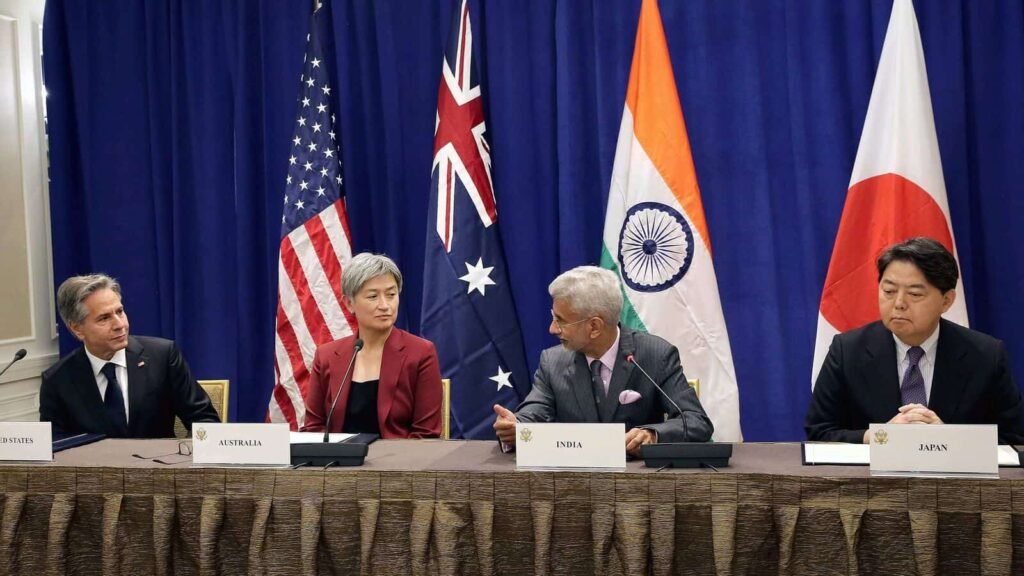Formation of QUAD and India’s interests

Understanding “Indo-Pacific”
In order to understand the initiative of “QUAD”, we need to understand what we mean by “Indo-Pacific” in politics. In its widest understanding, it refers to the nations and islands that surround either the Indian Ocean or the Pacific Ocean. In the 21st century, the rising involvement and interventions of the United States by the idea of the Indo- Pacific Corridor (IPEC) refers to the potential it holds on the prospects for development and investments.
The new alliances and diplomatic ties have emerged as a result of growing geopolitical prominence in the Indo-Pacific region. The “QUAD” is an informal multilateral organization that is on the rise and has intentions to include other nations in its membership in order to challenge China’s dominance in the region, both militarily and economically, and to work together on local and international issues. The reach of “QUAD” is reportedly greater than China’s government defences. Since each member state has different interests and stances toward the PRC, many people have questioned the necessity of the “QUAD.” The power war between China, which upholds the communist ideology, and the United States of America, which prides itself on being the home of liberty and opportunity.

Formation of QUAD
Quadrilateral Security Dialogue is also referred to as “QUAD” (QSD). The United States, Australia, India, and Japan have a strategic security discussion known as QUAD. The talks between the member nations were first started in 2007 by the late Shinzo Abe, the prime minister of Japan at the time. [1] He had the support of the then-prime ministers of India and Australia, Manmohan Singh and John Howard, respectively, as well as the vice president of the United States, Dick Cheney.
When the four member states took part in “The Malabar Naval Exercise,” a joint military exercise, they showed their desire to work together as a group. The QUAD came to an end the next year when Australia left the negotiations to pursue better diplomatic ties with China while Kevin Rudd was Prime Minister. [2]Senior officials from the four countries met in Manila, Philippines, in November 2017 to relaunch the strategic dialogue between the member governments. Senior officials from QUAD member governments have since convened eleven meetings to discuss issues of shared concern, participated in two more Malabar exercises, and finished a counterterrorism tabletop exercise.
The objective of QUAD
Through its wide and growing maritime claims in the South and the East China Sea, the “QUAD” seeks to protect human rights, the rule of law, respect for sovereignty and territorial integration, as well as the peaceful resolution of disputes in the “Indo-Pacific” area.[3] The member states may not agree with the concept, but “QUAD” is intended to be perceived as a reaction to China’s recent economic and military expansion in the Indo-Pacific region. However, the Chinese government objected to the QUAD plan and issued a formal diplomatic protest, referring to it as “Asian NATO.”
The QUAD is not an official military alliance. Instead, it is viewed as a network that links like-minded nations in an effort to advance the rule of law and directly and indirectly compete with China’s invasive maritime activities. As well as fighting terrorism, pandemics, and climate change, the “QUAD” has shown its commitment by bilaterally exchanging views on marine security, emerging technologies, connectivity, and infrastructure, as well as humanitarian aid and disaster assistance.
India’s interests in “QUAD”
The United States Secretary of State and the White House Principal Deputy Press Secretary support this assertion that India is significant because it is rapidly becoming a global economic and military power[4]. She also adds, “We recognize that India is a like-minded partner and leader in South Asia and the Indian Ocean, active in and connected to Southeast Asia, a driving force of the QUAD, and an engine for regional growth and development.”
Despite the notion of “America First,” the four partners’ shared desire for a “rules-based” order is quite evident. Since all of the member states of “QUAD” are maritime democracies with a strong shared interest in maritime security and freedom of navigation in the Indo-Pacific, even though China was not specifically mentioned, it can be considered a “useful instrument.” The summit, according to Indian Prime Minister Narendra Modi, is significant and is a “pillar of stability” for the Indo-Pacific region. The QUAD agreement allows India the chance to collaborate on a variety of multilateral projects that can contribute to the development of an open and free Indo-Pacific region. This time around, there is more alignment, although discrepancies still exist. However, India’s connection with China and its adherence to non-alignment complicate its commitment to the QUAD. The argument that QUAD will lead to a security quandary and an ensuing arms race is becoming less and less credible; rather, it can be understood as a response to China’s increasing assertiveness and military buildup.
“Different leaders, different thoughts”
Despite being quite ambiguous during Donald Trump’s administration[5], the US grand strategy shows a strong commitment to increasing its regional influence and acting as a leadership check on China. The ways that the United States of America and India approach international trade policy provide insight into the challenges associated with strengthening QUAD cooperation. The potential for effective cooperation is constrained by the consequent uncertainty about their viewpoint and position within the QUAD. One of the objectives is one of the most urgent obstacles. The QUAD is frequently criticized for having no overarching goal or significant mission. Furthermore, none of the goals listed as justifications for uniting the nations are exclusive to the QUAD. (ASEAN-based entities), and there are currently a large number of such organizations in the Asian region.

“Geopolitics, a crucial player”
Southeast Asia’s marine region is where the Indo-Pacific sub-regions geopolitically meet. As India continues to be very hesitant to forge an alliance with the West, good relations between India and the United States of America are very recent. In fact, a lot of Indians think the United States is a fickle ally.[6] This image has a long history that dates back to the Cold War when India was shunned by the world community after the 1947 nuclear test due to American cooperation with Pakistan. The Communist Party of India has recently been outspoken in its opposition to working with the Americans on the 2005 nuclear deal. Then, Dr Manmohan Singh, the prime minister of India, was compelled to reiterate India’s “independent foreign policy.” India, meanwhile, has its own development strategies. It is developing a fleet of nuclear attack submarines to increase both its second nuclear strike and deployment capabilities in the Indian Ocean. However, the US has stressed the “unique” nature of this partnership and does not want to increase its nuclear arsenal, opting to offer sporadic cooperation. Due to the constraints of the Indian-US Defense Trade and Technology Initiative, which was announced in 2012, and the two-tier strategy of collaboration among the Quad countries, nuclear energy cooperation between India and the US is not permitted in the “QUAD.”
Way Forward
The Quad is thought to be beneficial for maintaining regional stability. The question of whether the Quad would be a good endeavour is less important than the lack of clarity regarding the path that it will develop and act in. A second false start would be detrimental to the reputation of the Quad initiative and its participants.[7]The possible conflict would be overcome if the concerns raised by ASEAN, particularly those of Indonesia and Singapore, could be addressed. The fundamental worry of ASEAN member nations is that the Quad’s narrative and behaviour may be too hostile and compel them to make a decision. Canberra needs to be more aggressive in developing the Quad and its agenda. I believe that every state should have the freedom to associate, withdraw or remain neutral in international platforms and organisations, the state’s foreign policy should be based on the state’s interest and the citizens’. The formation of “QUAD” has the capability to ensure the balance of power in the Indo- pacific region, which is in the utmost concern in the given circumstances. However, India can use this as an opportunity to advance its influence and relations with the world. In specifications, QUAD needs to initiate a proper understanding and precise goals to remain relevant in everyday changing politics and build greater and deeper relations with the member states and showcase its capabilities and negotiate with other states to maintain world order and peace.
References
(2018, May 3). The US-Japan-India-Australia Quadrilateral Security Dialogue: Indo-Pacific alignment or foam in the ocean? Retrieved September 12, 2022, from https://www.fiia.fi/wp-content/uploads/2018/05/bp239_quad.pdf
Defining the Diamond: The Past, Present, and Future of the Quadrilateral Security Dialogue. (2020, March 16). CSIS. Retrieved September 12, 2022, from https://www.csis.org/analysis/defining-diamond-past-present-and-future-quadrilateral-security-dialogue
Home. (n.d.). YouTube. Retrieved September 12, 2022, from https://www.google.co.in/books/edition/Minilateralism_in_the_Indo_Pacific/ek_hDwAAQBAJ?hl=en&gbpv=1&dq=Quadrilateral+Security+Dialogue&pg=PT10&printsec=frontcover
Quad Leaders’ Joint Statement: “The Spirit of the Quad”. (2021, March 12). The White House. Retrieved September 12, 2022, from https://www.whitehouse.gov/briefing-room/statements-releases/2021/03/12/quad-leaders-joint-statement-the-spirit-of-the-quad/
THE QUADRILATERAL SECURITY DIALOGUE:. (n.d.). S. Rajaratnam School of International Studies. Retrieved September 12, 2022, from https://openresearch-repository.anu.edu.au/bitstream/1885/165930/1/PR190909_The-Quadrilateral-Security-Dialogue.pdf
Smith, S. A. (2021, May 27). The Quad in the Indo-Pacific: What to Know. Council on Foreign Relations. Retrieved September 12, 2022, from https://www.cfr.org/in-brief/quad-indo-pacific-what-know
Southeast Asian perceptions of the Quadrilateral Security Dialogue – Survey findings. (n.d.). AWS. Retrieved September 12, 2022, from http://ad-aspi.s3.amazonaws.com/2018-10/SR%20130%20Quadrilateral%20security%20dialogue.pdf
[1] (2018, May 3). The US-Japan-India-Australia Quadrilateral Security Dialogue: Indo-Pacific alignment or foam in the ocean? Retrieved September 12, 2022, from https://www.fiia.fi/wp-content/uploads/2018/05/bp239_quad.pdf
[2] Defining the Diamond: The Past, Present, and Future of the Quadrilateral Security Dialogue. (2020, March 16). CSIS. Retrieved September 12, 2022, from https://www.csis.org/analysis/defining-diamond-past-present-and-future-quadrilateral-security-dialogue
[3] Home. (n.d.). YouTube. Retrieved September 12, 2022, from https://www.google.co.in/books/edition/Minilateralism_in_the_Indo_Pacific/ek_hDwAAQBAJ?hl=en&gbpv=1&dq=Quadrilateral+Security+Dialogue&pg=PT10&printsec=frontcover
[4] Quad Leaders’ Joint Statement: “The Spirit of the Quad”. (2021, March 12). The White House. Retrieved September 12, 2022, from https://www.whitehouse.gov/briefing-room/statements-releases/2021/03/12/quad-leaders-joint-statement-the-spirit-of-the-quad/
[5] THE QUADRILATERAL SECURITY DIALOGUE:. (n.d.). S. Rajaratnam School of International Studies. Retrieved September 12, 2022, from https://openresearch-repository.anu.edu.au/bitstream/1885/165930/1/PR190909_The-Quadrilateral-Security-Dialogue.pdf
[6] Smith, S. A. (2021, May 27). The Quad in the Indo-Pacific: What to Know. Council on Foreign Relations. Retrieved September 12, 2022, from https://www.cfr.org/in-brief/quad-indo-pacific-what-know
[7] Southeast Asian perceptions of the Quadrilateral Security Dialogue – Survey findings. (n.d.). AWS. Retrieved September 12, 2022, from http://ad-aspi.s3.amazonaws.com/2018-10/SR%20130%20Quadrilateral%20security%20dialogue.pdf



















